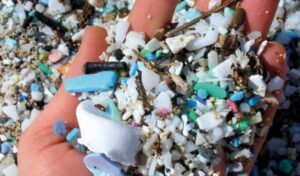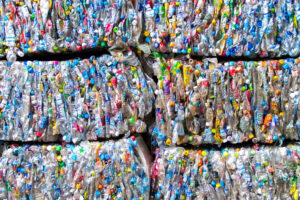- Regulatory Tools
- Circular Economy
- Government
- Government Policy
- Labelling
- Recycling
- Policy
- Strategy and Policy
- Take Action
- National
This home was once 600,000 plastic bottles
A 1,300-square foot cabin in Jackfish Lake, Sask., is the product of upcycling hundreds of thousands of plastic bottles.
“The outside of it, definitely, people are wondering what the product is because it’s not wood, obviously,” owner and Lloydminster resident Erin Schira laughed.
The giant greyish sheets that make up the structure – some of which were two storeys tall and needed to be set in place with a crane – weren’t the only attention-grabbing feature of the building process: The shell of the cabin only took three days to erect.
“It’s kind of like Minecraft or LEGOs; it’s prefabbed in the shop and they just come out with pickers and they just put it up so quickly…. It’s the neatest thing,” Schira recalled.
The Alberta home builder behind the design and construction, Ecoplast Solutions, claims to be the first in the world to be building residential structures with foam core made from upcycled plastic waste.
On average, a home built by the Lloydminster-based company contains more than 600,000 plastic bottles that have been shredded, melted and blown into a closed-cell high-density structural foam.
The plastic is processed and manufactured into sheets in eastern Canada, by Ecoplast’s partner, JD Composites. Ecoplast puts together the massive panels that eventually make up a home’s wall and roof systems, and laminates it all into one monolithic structure.
As of early summer 2022, six such homes had been built in Canada.
“Entering an industry that’s been around for such a long time, and it’s been done the same way for so long … it’s hard for people to envision what we’re doing as a viable option,” Ecoplast managing partner Kelly Rogers acknowledges.
“We’re disrupting the industry a bit.”
The technology isn’t new; foam core materials have been used in marine construction for decades because of the product’s strength and durability. But it is new to the housing sector.
“Because it’s a closed-cell high-density foam and it’s impermeable to moisture, you don’t lose your efficiency or your R-value over time,” Rogers told CTV News Edmonton. “And critters, they can’t get in the walls to destroy that either.”



